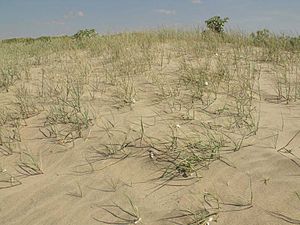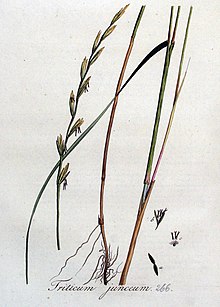Rush couch grass
| Rush couch grass | ||||||||||||
|---|---|---|---|---|---|---|---|---|---|---|---|---|

Common couch grass ( Elymus farctus ) |
||||||||||||
| Systematics | ||||||||||||
|
||||||||||||
| Scientific name | ||||||||||||
| Elymus farctus | ||||||||||||
| ( Viv. ) Runemark ex Melderis |
The rush-couch grass ( Elymus farctus , Syn .: Thinopyrum junceum ), even beach-couch grass or beach wheat called, is a plant of the genus of couch grass ( Elymus ) within the family of the sweet grasses (Poaceae).
description
Vegetative characteristics
The common couch grass grows as a perennial herbaceous plant and reaches heights of 20 to 60 centimeters. There are long rhizomes . The stalks are upright.
The leaves arranged on the stalk are divided into leaf sheath and leaf blade. The bald leaf sheaths have no auricles. The membranous ligule is 0.5 to 1 millimeter long, truncated and is not ciliate. The simple, stiff or firm, blue-green leaf blade is flat or rolled up, 10 to 35 centimeters long and 2 to 6 millimeters wide with a piercing, pointed upper end. The top of the leaf blade is ribbed and densely hairy and the underside is glabrous.
Generative characteristics
It's a wheat grass. The upright single spike inflorescence is 4 to 20 centimeters long. On the almost pedicel-round inflorescence rhachis , which is fragile at the nodes, the broadside of the sitting spikelets is always two-lined apart at a distance of one to twice their length from each other. The rachis section falls off when ripe with the spikelet overlying it.
The fertile spikelets contain three to eight fertile flowers and reduced flowers at the top. The spikelets are laterally flattened and with a length of 15 to 28 millimeters elongated or wedge-shaped in outline. When ripe, the spikelets disintegrate piece by piece under each fertile flower. The thickening of the lemma at the point of attachment of the flower on the axis of the spikelet is glabrous with a truncated base. The axis intercepts are covered by the lemmas.
The durable, with a length of 9 to 20 millimeters oblong glumes are almost the same, slightly different in width and shorter than the spikelets and pointed at the upper end. The lower glume is leathery and smooth with a keel and seven to eight nerves, the lateral ones of which are ribbed. The lower glume is leathery and smooth with a keel and seven to eleven nerves, the lateral ones of which are ribbed. There is no awn on the glume .
The glumes are 0.9 times as long or the same length as the adjacent fertile lemma. The fertile lemmas are leathery and elongated and keeled and five-nerved with a length of 11 to 20 millimeters. The upper end of the lemma is edged or blunt with a prickly tip. The palea 0.8 times as long as the glumes. The palea are lanceolate and two-veined with ciliate keels. The top flowers are sterile and resemble fertile ones, except that they are not fully developed. The two lodiculae (cavernous bodies) are membranous and elliptical. The three anthers are 6 to 8 millimeters long. The ovary is hairy on the upper end. The two scars protrude from the side.
The sessile, spindle-shaped, isodiametric, smooth caryopsis has an adherent pericarp and no sulcus; there is no appendage at the top. The embryo 0.2 times as long as the caryopsis. The linear hilum 0.9 times as long as the caryopsis. The endosperm is floury.
The number of chromosomes is 2n = 28.
ecology
The propagation also takes place vegetatively through the runners. The rush couch grass is plurienn-pollakanth, which means a specimen blooms and fruit more than once in its life, so it is persistent. There is proterandry (pre-masculinity). The pollination is carried by the wind. The common couch grass is self-incompatible, which means self-fertilization and seed set is prevented by a genetically determined mechanism. Diaspores are the caryopses.
Occurrence
Elymus farctus occurs widely in northern , central , southwest , southeast , and eastern Europe , North Africa and Macaronesia , western Asia and a neophyte in Australia , New Zealand and North America . There are sites in France including Corsica , Portugal , Spain including the Balearic Islands , in northern Algeria , in Morocco , Tunisia , in northwestern Libya , northern Egypt , in Israel , Lebanon , in western Syria , in western Turkey , in Cyprus , Greece including Crete , Albania , Bulgaria , Romania , Croatia , Slovenia , Italy , including Sardinia and Sicily , Germany , Belgium , Netherlands , Poland , United Kingdom , Ireland , Faroe Islands, Denmark , Sweden , Finland , Norway , Svalbard , Jan Mayen , Estonia , Latvia , Lithuania , Ukraine , Crimea and Georgia .
In Germany the rush couch grass is quite common on the North and Baltic Sea coasts. The common couch grass is not endangered for the whole of Germany and for the federal states in which it occurs.
The rushes Wheatgrass is an element of beach dunes companies ( Class : Ammophiletea arenariae) and Kennart the Association Agropyretum juncei (Elymetum farcti) Tx. 1937 corr. Oberd. 1983 (Agropyretum boreo-atlanticum Tx. 1937) from the Elymo-Honkenyion peploidis association.
The common couch grass thrives on sandy soils , especially on dunes , and solidifies the soil with its widely branched and robust rhizomes and holds on to flood sand. As a result, this salt-tolerant plant is involved in the formation of primary dunes .
Taxonomy
The first publication took place under the name ( Basionym ) Triticum farctum by the Italian botanist Domenico Viviani (1772-1840). The new combination to Elymus farctus (Viv.) Runemark ex Melderis was made by the Swedish botanist Hans Runemark (* 1927). The specific epithet farctum / farctus means stuffed full.
Synonyms for Elymus farctus (Viv.) Runemark ex Melderis are: Agropyron farctum Boiss. , Agropyron farctum (Viv.) Rothm. , Agropyron × hackelii Druce , Agropyron junceiforme (Á.Löve & D.Löve) Á.Löve & D.Löve , Agropyron junceum (L.) P.Beauv. , Agropyron sartorii (Boiss. & Heldr.) Grecescu , Braconotia juncea (L.) Godr. , Bromus truncatus Scop. , Elymus junceiformis (Á.Löve & D.Löve) Hand & Buttler , Elymus multinodus Gould , Elymus striatulus Runemark , Elytrigia farcta (Viv.) Holub , Elytrigia juncea (L.) Nevski , Elytrigia junceiformis Á.Löve & D.Löve , Elytrigia mediterranea (Simonet) Prokudin , Elytrigia sartorii (Boiss. & Heldr.) Holub , Elytrigia striatula (Runemark) Holub , Festuca juncea (L.) Moench , Frumentum junceum (L.) EHLKrause , Thinopyrum junceiforme (Á.Löve & D.Löve & D. Löve) Á.Löve , Thinopyrum junceum (L.) Á.Löve , Thinopyrum runemarkii Á.Löve , Thinopyrum sartorii (Boiss. & Heldr.) Á.Löve , Triticum glaucum Link , Triticum junceum L. , Triticum litoreum bread. , Triticum sartorii (Boiss. & Held.) Boiss. & Hero. ex Nyman .
The accepted name seems to be Thinopyrum junceum (L.) Á.Löve . The genus Thinopyrum was established in 1980 by Áskell Löve in Taxon , Volume 29, p. 351 (Áskell Löve: Conspectus of the Triticeae. In: Feddes Repert. Volume 95, 1984, pp. 425-521) and contains about 20 species. Belonging to the genera Elymus , Thinopyrum and Elytrigia is controversial.
swell
- WD Clayton, M. Vorontsova, KT Harman, H. Williamson: Datasheet at GrassBase - The Online World Grass Flora by The Board of Trustees, Royal Botanic Gardens, Kew.
- Aleksandre Melderis: Elymus . In: TG Tutin, VH Heywood, NA Burges, DM Moore, DH Valentine, SM Walters, DA Webb (eds.): Flora Europaea . tape 5 - Alismataceae to Orchidaceae (Monocotyledones) . Cambridge University Press, Cambridge 1980, ISBN 0-521-20108-X , Gramineae, pp. 197–198 ( Elymus farctus with the European subspecies on pp. 197–198 in the Google book search).
Individual evidence
- ↑ a b c d Elymus farctus (Viv.) Runemark ex Melderis, Rush-couch grass. In: FloraWeb.de.
- ↑ a b c d e f g h i j k l m WD Clayton, M. Vorontsova, KT Harman, H. Williamson: Datasheet at GrassBase - The Online World Grass Flora from The Board of Trustees, Royal Botanic Gardens, Kew.
- ↑ a b c Aleksandre Melderis: Elymus . In: TG Tutin, VH Heywood, NA Burges, DM Moore, DH Valentine, SM Walters, DA Webb (eds.): Flora Europaea . tape 5 - Alismataceae to Orchidaceae (Monocotyledones) . Cambridge University Press, Cambridge 1980, ISBN 0-521-20108-X , Gramineae, pp. 197–198 ( Elymus farctus with the European subspecies on pp. 197–198 in the Google book search).
- ↑ a b Erich Oberdorfer : Plant-sociological excursion flora for Germany and neighboring areas . 8th edition. Stuttgart, Verlag Eugen Ulmer, 2001. ISBN 3-8001-3131-5 . Page 233.
- ↑ a b Elytrigia junceiformis Á. Löve & D. Löve - Binsen-Quecke - Datasheet ( Memento of the original from February 26, 2015 in the Internet Archive ) Info: The archive link has been inserted automatically and has not yet been checked. Please check the original and archive link according to the instructions and then remove this notice. at BiolFlor - A database with biological-ecological characteristics of the flora of Germany . ( Memento of the original from March 6, 2015 in the Internet Archive ) Info: The archive link was inserted automatically and has not yet been checked. Please check the original and archive link according to the instructions and then remove this notice.
- ↑ a b Elymus farctus - data sheet at FloraOn of the Sociedade Portuguesa de Botânica .
- ↑ Entry in the Flora Vascular .
- ↑ Elymus farctus subsp. farctus - data sheet with photos at Schede di Botanica - Flora Italiana .
- ↑ Elytrigia juncea at West Highland Flora , UK. - Brief description and photos.
- ^ A b Thinopyrum junceum in Germplasm Resources Information Network (GRIN), USDA , ARS , National Genetic Resources Program. National Germplasm Resources Laboratory, Beltsville, Maryland. Retrieved February 20, 2015.
- ↑ Photos by Michael Hassler and Bernd Schmitt: Elytrigia junceiformis A. & D. Löve (Binsen-Quecke) - data sheet at Plant World of Germany .
- ↑ Dietmar Aichele, Heinz-Werner Schwegler: Our grasses. Sweet grasses, sour grasses, rushes (= Kosmos nature guide). 7th edition. Franckh'sche Verlagsbuchhandlung, Stuttgart 1984, ISBN 3-440-05284-2 .
- ↑ Thinopyrum junceum - data sheet at GrassWorld .
- ↑ Thinopyrum junceum (L.) Á.Löve - e-Monocot data sheet. ( Memento of the original from February 26, 2015 in the Internet Archive ) Info: The archive link was inserted automatically and has not yet been checked. Please check the original and archive link according to the instructions and then remove this notice.
- ↑ Elymus farctus (Viv.) Runemark ex Melderis - EOL data sheet.
- ↑ Benito Valdés, Hildemar Wolfgang Scholz, with the participation of Eckhard von Raab-Straube, Gerald Parolly, 2009: Poaceae (pro parte majore). : Elytrigia juncea (L.) Nevski - data sheet at Euro + Med Plantbase - The information resource for Euro-Mediterranean plant diversity .
- ↑ Thinopyrum junceiforme (Á.Löve & D.Löve) Á.Löve - data sheet at AusGrass2 - Grasses of Australia .
- ↑ Thinopyrum junceiforme (Á.Löve & D.Löve) Á.Löve - data sheet at VicFlora - Flora of Victoria .
- ↑ Thinopyrum junceiforme (Á.Löve & D.Löve) Á.Löve - data sheet at APNI - Australian Plant Name Index .
- ↑ Thinopyrum junceiforme (Á. Löve & D. Löve) Á. Lion - USDA Datasheet.
- ↑ Rafaël Govaerts (ed.): Thinopyrum junceum. In: World Checklist of Selected Plant Families (WCSP) - The Board of Trustees of the Royal Botanic Gardens, Kew . Retrieved May 29, 2020.
- ^ RR-C. Wang, et al .: Analyzes of Thinopyrum bessarabicum, T. elongatum, and T. junceum chromosomes using EST-SSR markers. In: Genome , Volume 53: 2010, pp. 1083-1089.
Web links
- Rush couch grass . In: BiolFlor, the database of biological-ecological characteristics of the flora of Germany.
- Distribution in the Netherlands (Dutch)
- Distribution in the northern hemisphere.
- Thomas Meyer: Data sheet with identification key and photos at Flora-de: Flora von Deutschland (old name of the website: Flowers in Swabia )
- Elymus farctus - data sheet with photos.
- Photos of herbarium specimens.


